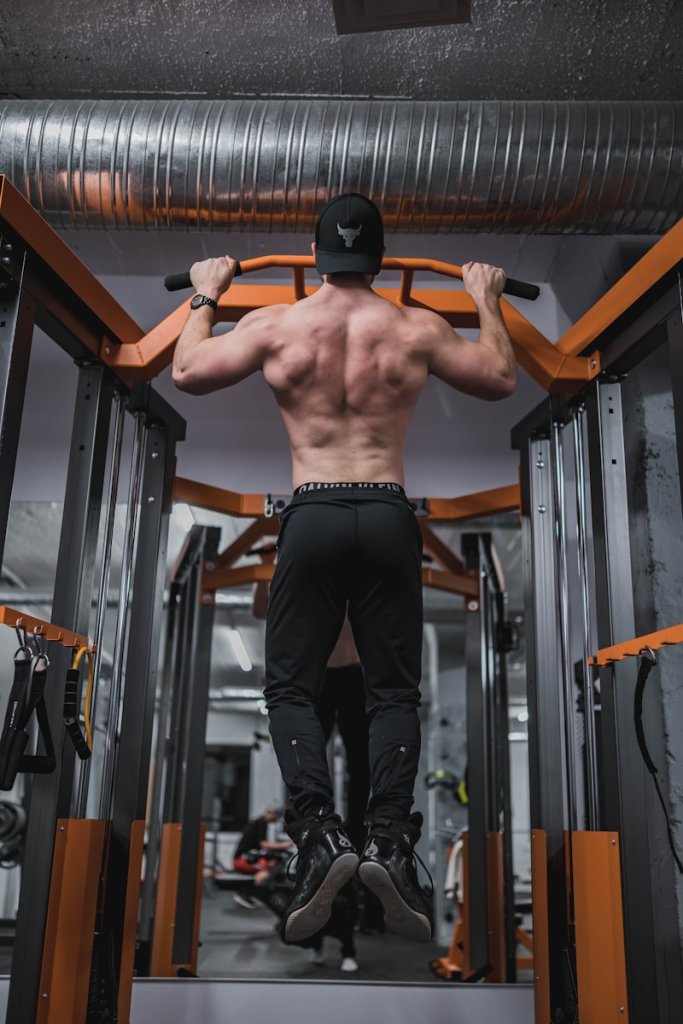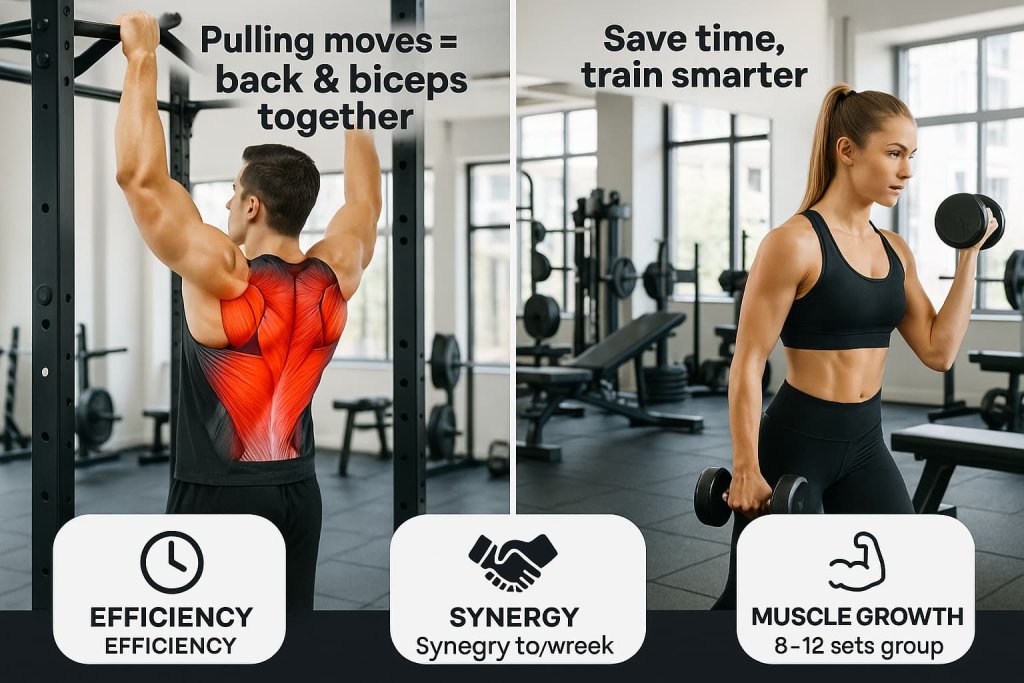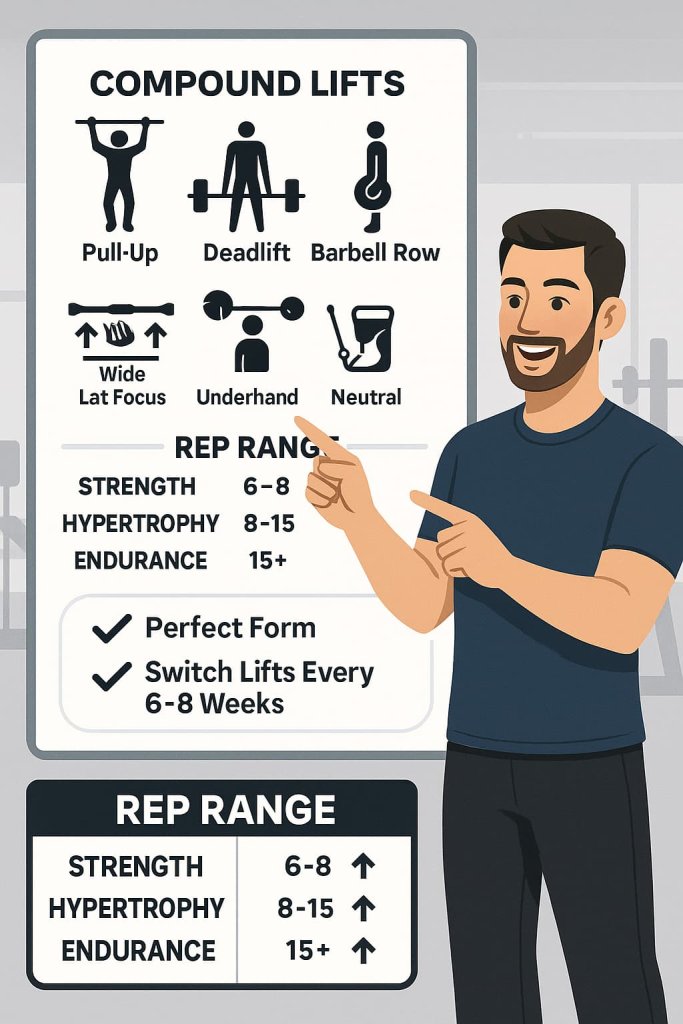The best back and bicep workouts use proven, science-backed exercises such as pull-ups, rows, and curls to maximize muscle growth, strength, and definition, as endorsed by leading trainers.
Pairing back and biceps is not just popular in gyms—it’s recommended by exercise science. That’s because almost every pulling exercise for your back also challenges your biceps, making these two muscle groups a perfect training pair for faster, more efficient results.

Mastering the right exercises can help you:
- Build muscle and strength quickly
- Prevent posture and shoulder problems
- Avoid common gym mistakes
- Get results even if you’re training at home or with minimal equipment
This comprehensive guide reveals the 15 best back and biceps exercises, explains the science, details sets/reps, and answers common questions—so you can train smarter and see results faster.
Why Train Back and Biceps Together?
Back and biceps workouts are efficient because both muscle groups work during pulling movements.

Scientific studies and top trainers agree:
- Back exercises like rows, pull-downs, and pull-ups all recruit the biceps.
- Combining both in one session saves time and increases training volume for both muscle groups.
- Synergy: Training back first (when you’re strongest) allows you to use heavier weights, then finish with focused bicep work for maximum fatigue and growth.
A recent analysis (2024) recommends a minimum of 8–12 sets per muscle group per week for optimal hypertrophy and strength gains. Most routines start with multi-joint back moves (pull-ups, rows) before switching to isolation (curls).
Why is this pairing so effective?
- You maximize muscle fiber recruitment and save warmup time.
- You minimize arm fatigue before heavier lifts.
- You boost efficiency for busy schedules or 3–4 day splits.
How to Choose the Best Back and Bicep Exercises

Trainer-Approved, Science-Backed Selection Principles:
- Start with heavy compound lifts: These hit both back and biceps, promote growth hormone release, and build overall mass (e.g., pull-ups, deadlifts, barbell rows).
- Follow with isolation moves: Curls, cable exercises, and specific angles target different heads of the biceps for balanced arm growth.
- Vary your grips:
- Wide grip: More lat activation
- Underhand/supinated: More bicep focus
- Neutral/hammer: Balanced forearm and biceps
- Use the right rep ranges:
- Strength: 6–8 reps, heavier weight
- Hypertrophy: 8–15 reps, moderate weight
- Endurance: 15+ reps, lighter weight
- Prioritize perfect form: Poor form limits muscle engagement and increases injury risk—especially for rows and curls.
Pro Tip: Switch your main lifts every 6–8 weeks to avoid plateaus, and use techniques like slow negatives (eccentric) or drop sets for variety.
The 15 Best Back and Bicep Exercises (Detailed Guide)
1. Pull-Up / Chin-Up
Why:
Pull-ups and chin-ups deliver the highest EMG activation for both the lats and biceps. Pull-ups (overhand grip) prioritize the lats and upper back, while chin-ups (underhand grip) shift more tension to the biceps.
How to Do It:
- Grip a pull-up bar, hands shoulder-width or wider (pull-up = overhand; chin-up = underhand).
- Hang fully extended, core and glutes tight.
- Pull chest to bar, keeping elbows driving down and back.
- Lower with control.
Trainer Tips:
- Start with band assistance or machine if you can’t do full reps.
- Add a weight belt or slow tempo for progression.
- Focus on full range of motion—chin over the bar at the top, arms straight at the bottom.
2. Bent-Over Barbell Row
Why:
A staple for building total back thickness—engages mid-back, lats, rear delts, lower traps, and biceps.
How to Do It:
- Stand, feet hip-width, hold barbell with overhand grip.
- Hinge at hips (back flat, knees slightly bent).
- Row bar to lower chest/ribcage.
- Lower bar slowly, maintaining torso angle.
Trainer Tips:
- Keep core braced, avoid rounding lower back.
- Use straps if grip is limiting.
Sets/Reps: 3–4 sets, 8–12 reps.
3. Single-Arm Dumbbell Row (Kroc Row)
Why:
Excellent for muscle imbalances and deep lat stretch; one of the best unilateral (single-sided) back builders.
How to Do It:
- Place one knee and hand on a bench, other foot planted.
- Hold dumbbell in free hand, arm straight.
- Pull dumbbell toward hip, pause and squeeze back.
- Lower slow.
Trainer Tips:
- Let shoulder blade move freely.
- Use heavier weight for strength, lighter for form.
4. Lat Pulldown (Wide or Neutral Grip)
Why:
User-friendly alternative to pull-ups—lets you change grip and resistance for optimal lat targeting.
How to Do It:
- Sit at lat pulldown, grab bar wider than shoulders (overhand or neutral).
- Pull bar to upper chest, keeping elbows down.
- Slowly return bar until arms are extended.
Trainer Tips:
- Don’t lean too far back or swing.
- Pause at bottom for maximum contraction.
5. Seated Cable Row
Why:
Provides constant tension and is easy on the lower back; hits the mid-back, lats, and biceps.
How to Do It:
- Sit with feet braced, grab handles (neutral grip).
- Pull handles to lower ribcage, squeeze shoulder blades together.
- Return slowly, keeping torso steady.
Trainer Tips:
- Avoid rounding shoulders at front.
- Vary grip to target different areas.
6. T-Bar Row
Why:
Perfect for lower lats, back thickness, and safe heavy loading; chest support helps reduce lower back strain.
How to Do It:
- Stand over T-bar row or landmine row setup.
- Chest pressed against pad, grab handles.
- Pull to upper abs, elbows close to sides.
- Lower with control.
Trainer Tips:
- Focus on back squeeze, not just arm pulling.
- Don’t shrug shoulders.
7. Inverted Row (Bodyweight Row)
Why:
Great for beginners, high reps, and posture—trains upper back and biceps with bodyweight.
How to Do It:
- Set bar or suspension straps at waist height.
- Lie underneath, grab bar/handles.
- Keep body straight, pull chest to bar.
- Lower with control.
Trainer Tips:
- Elevate feet for more difficulty.
- Squeeze glutes/core to avoid sagging.
8. Deadlift or Rack Pull
Why:
The king of posterior chain training—hits all major back muscles, glutes, hamstrings, forearms, and grip. Deadlifts are backed by EMG studies as one of the best for total muscle activation (BarBend, 2024).
How to Do It:
- Feet hip-width, grip bar just outside legs.
- Hinge at hips, chest up, back flat.
- Drive through feet to stand up, hips and shoulders rise together.
- Lower with control.
Trainer Tips:
- Use rack pulls to reduce range if needed.
- Never round lower back.
9. Straight-Arm Lat Pulldown
Why:
Isolates the lats with minimal biceps involvement; perfect finisher for back day.
How to Do It:
- Stand at high cable, grab bar or rope, arms straight.
- Pull bar down to thighs, lean forward slightly.
- Control return.
Trainer Tips:
- Keep elbows soft, not locked.
- Focus on squeezing lats.
10. Face Pull (Cable or Band)
Why:
Vital for rear delts, upper traps, and rotator cuff health—improves posture and shoulder stability.
How to Do It:
- Set rope at face height.
- Pull handles toward face, elbows high.
- Pause and squeeze at end.
Trainer Tips:
- Use light to moderate weight, perfect form.
- Great as a warm-up or finisher.
11. Hammer Curl
Why:
Targets the brachialis and brachioradialis (muscles beneath the biceps), which builds bigger, thicker arms.
How to Do It:
- Stand or sit, dumbbells at sides, palms facing in.
- Curl weights up, keep wrists neutral.
- Lower slow.
Trainer Tips:
- Avoid swinging; control the weight.
- Great for elbow health.
12. EZ-Bar Curl or Preacher Curl
Why:
Direct biceps work with less wrist strain; preacher curls emphasize isolation and strict form.
How to Do It:
- EZ-Bar: Stand, elbows fixed to sides, curl up and lower slow.
- Preacher: Sit at preacher bench, arms on pad, curl bar or dumbbell up.
Trainer Tips:
- Don’t let elbows move forward.
- Go slow for maximum tension.
13. Spider Curl (Incline Dumbbell Curl)
Why:
Unique angle for peak contraction and long-head stretch—helps maximize biceps height.
How to Do It:
- Lie chest-down on incline bench, arms hanging.
- Curl dumbbells up, squeeze at top.
- Lower fully.
Trainer Tips:
- Use light to moderate weights.
- Full range, slow tempo.
14. Concentration Curl
Why:
Best for mind-muscle connection and biceps peak; focuses on strict, isolated movement.
How to Do It:
- Sit, elbow braced on inner thigh.
- Curl dumbbell up, squeeze hard at top.
- Lower slowly.
Trainer Tips:
- Don’t use body momentum.
- Focus on the squeeze.
15. Overhead Cable Curl
Why:
Keeps biceps under tension through the whole range; great finisher and for biceps shape.
How to Do It:
- Set cables high, stand between, grab handles.
- Arms outstretched, curl hands to ears.
- Lower slow.
Trainer Tips:
- Use lighter weight for perfect form.
- Don’t shrug shoulders.
Science-Backed Programming Tips
- Mix vertical pulls (pull-ups, lat pulldowns) and horizontal pulls (rows, cable rows) for balanced back development.
- For size and strength: Aim for 8–12 reps, 3–4 sets per exercise.
- Don’t skip biceps isolation: These moves add peak and width that compound lifts miss.
- Progressive overload: Gradually increase weights, reps, or tempo to keep growing.
- Use perfect form: Prioritize range of motion and muscle engagement over heavy weights.
Sample Back and Bicep Workout (With Sets & Reps)
| Exercise | Sets | Reps |
|---|---|---|
| Pull-Up or Lat Pulldown | 4 | 6–10 |
| Barbell Row | 3 | 8–12 |
| Single-Arm DB Row | 3 | 10–12 |
| Seated Cable Row | 3 | 10–15 |
| Face Pull | 2 | 12–15 |
| Hammer Curl | 3 | 8–12 |
| EZ-Bar or Spider Curl | 3 | 10–15 |
| Overhead Cable Curl | 2 | 12–15 |
Weekly Programming:
Train back and biceps 2x per week
Use different variations and grips each session
Progress by adding reps or weight each week
Common Questions & Pro Trainer Tips
How many sets for muscle growth?
Aim for 8–12 sets per muscle group per week for optimal hypertrophy.
Can I do this at home?
Yes—use pull-ups, inverted rows under a sturdy table, resistance bands, or dumbbells.
Do I need gym machines?
No, but machines and cables add variety and constant tension—great for isolation.
Should I switch grips and angles?
Absolutely. Rotate your grips (overhand, underhand, neutral) and vary elbow positions to hit all muscle fibers.
Is form or weight more important?
Form is always number one. Control every rep and avoid swinging or using momentum.
Conclusion
These 15 science-backed, trainer-approved exercises will help you build a bigger, stronger back and biceps in less time.
Combine compound lifts and isolation work, keep your form strict, and track your progress week by week.
Want faster results? Start this routine today, adjust as you get stronger, and check the latest official resources for updates.
